Abstract
The anesthetic potency and cardiopulmonary effects of sevoflurane were compared with those of isoflurane and halothane in goats. The (mean +/- SD) minimal alveolar concentration (MAC) was 0.96 +/- 0.12% for halothane, 1.29 +/- 0.11% for isoflurane, and 2.33 +/- 0.15% for sevoflurane. Cardiopulmonary effects of sevoflurane, halothane and isoflurane were examined at end-tidal concentrations equivalent to 1, 1.5 and 2 MAC during either spontaneous or controlled ventilation (SV or CV). During SV, there were no significant differences in respiration rate, tidal volume and minute ventilation between anesthetics. Dose-dependent decreases in both tidal volume and minute ventilation induced by halothane were greater than those by either sevoflurane or isoflurane. Hypercapnia and acidosis induced by sevoflurane were not significantly different from those by either isoflurane or halothane at 1 and 1.5 MAC, but were less than those by halothane at 2 MAC. There was no significant difference in heart rate between anesthetics during SV and CV. During SV, all anesthetics induced dose-dependent decreases in arterial pressure, rate pressure product, systemic vascular resistance, left ventricular minute work index and left ventricular stroke work index. Systemic vascular resistance with isoflurane at 2 MAC was lower than that with sevoflurane. During CV, sevoflurane induced dose-dependent circulatory depression (decreases in arterial pressure, cardiac index, rate pressure product, systemic vascular resistance, left ventricular minute work index and right ventricular minute work index), similar to isoflurane. Halothane did not significantly alter systemic vascular resistance from 1 to 2 MAC.
Full text
PDF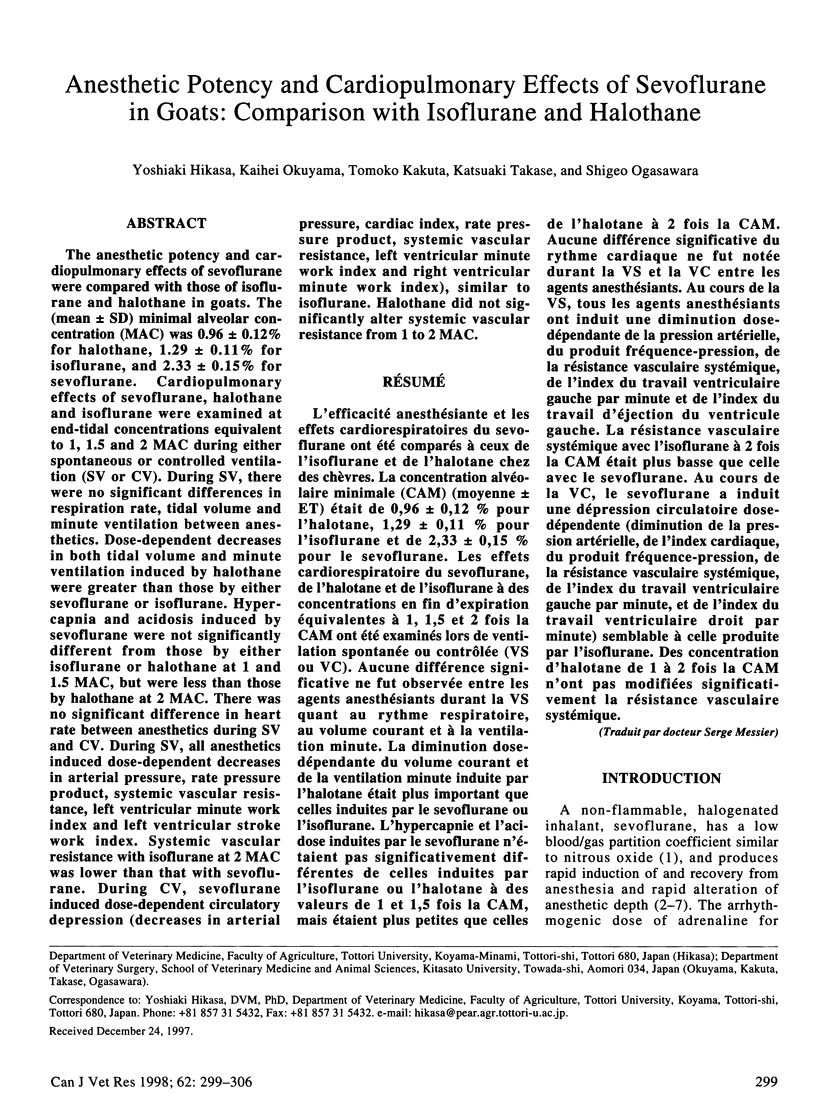
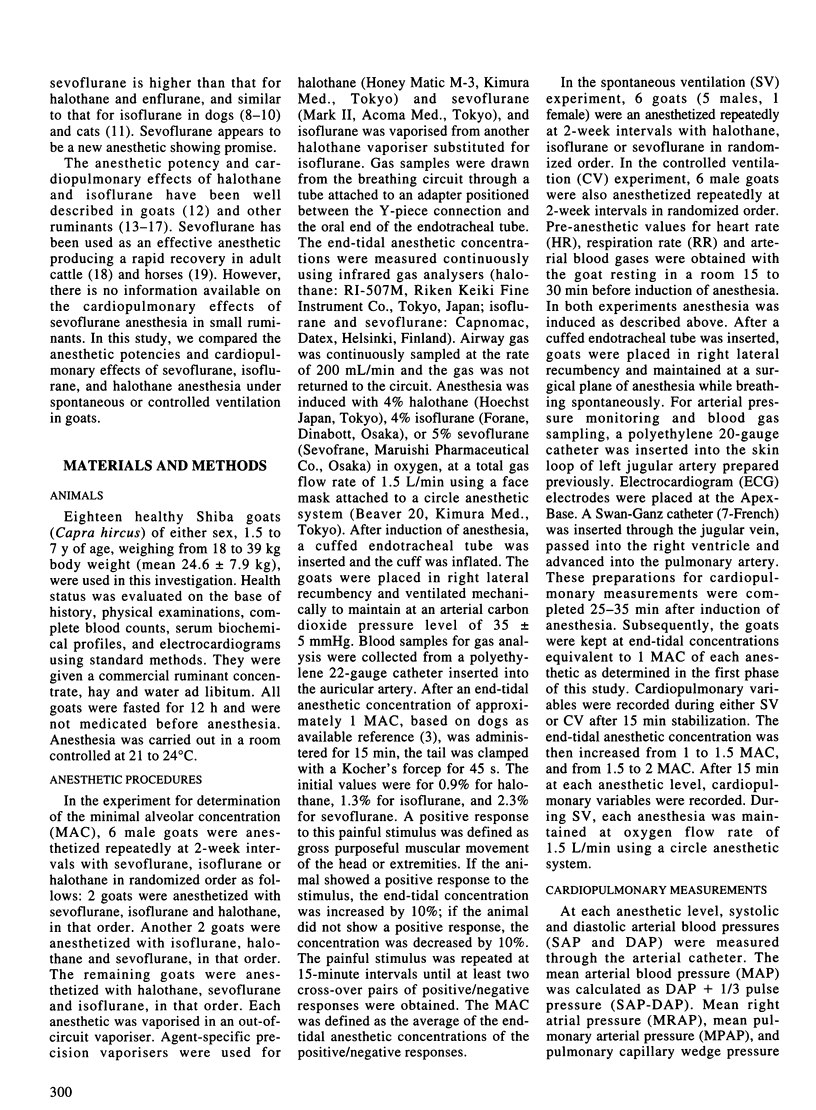

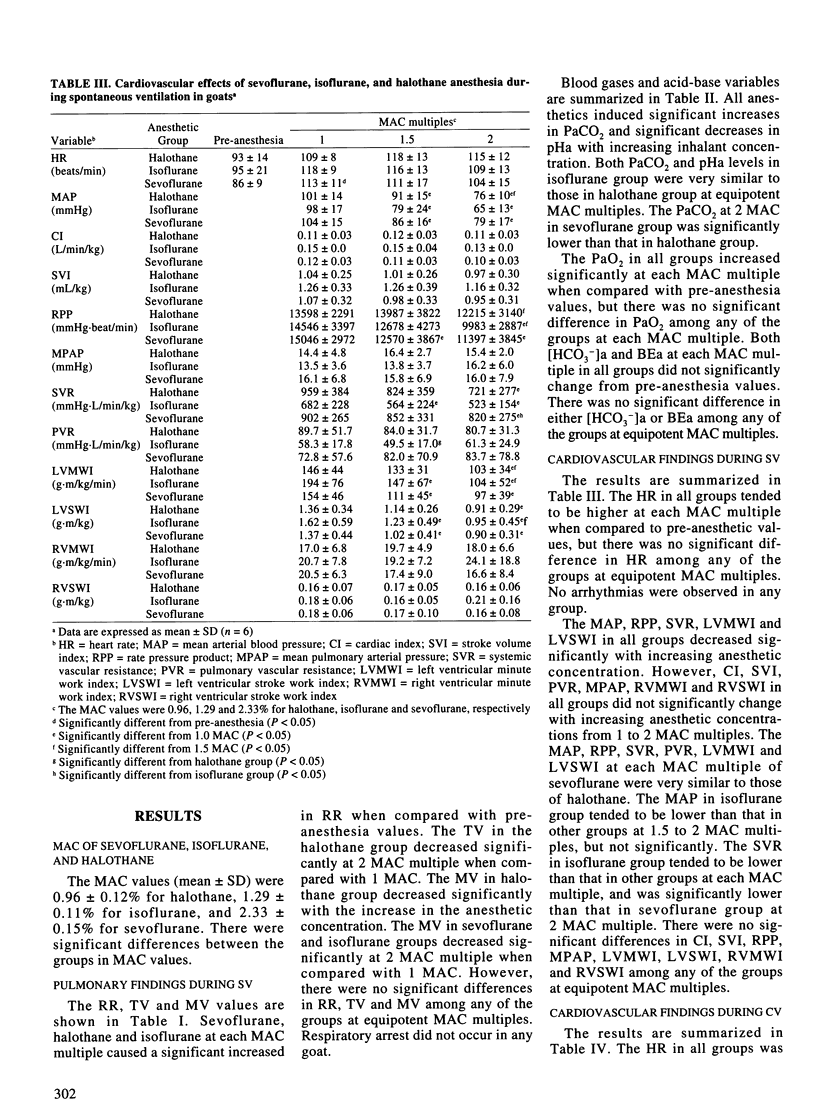
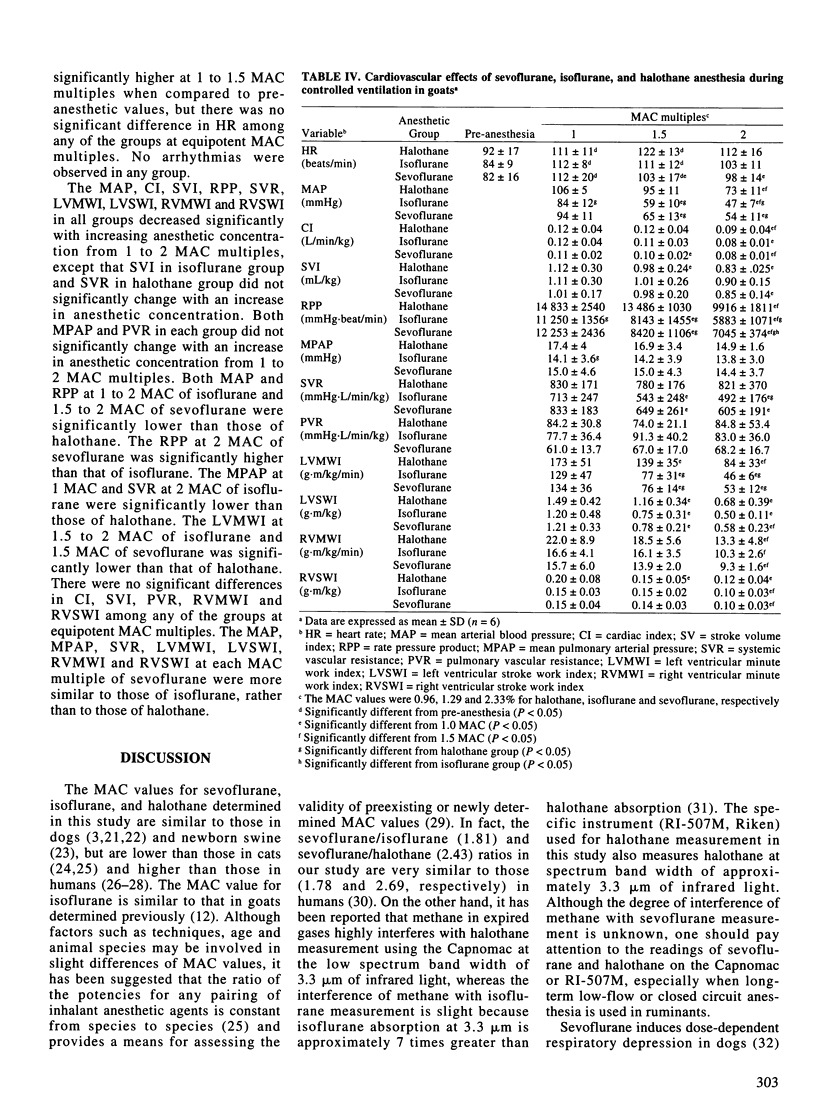
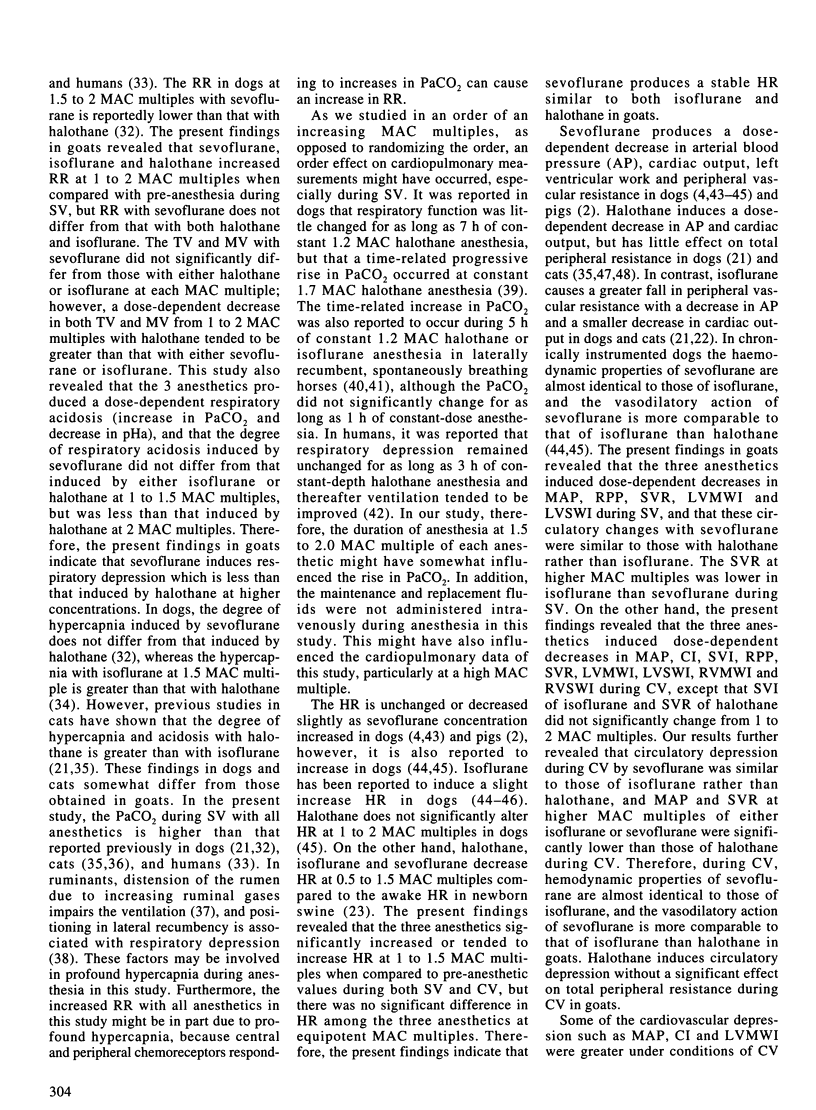
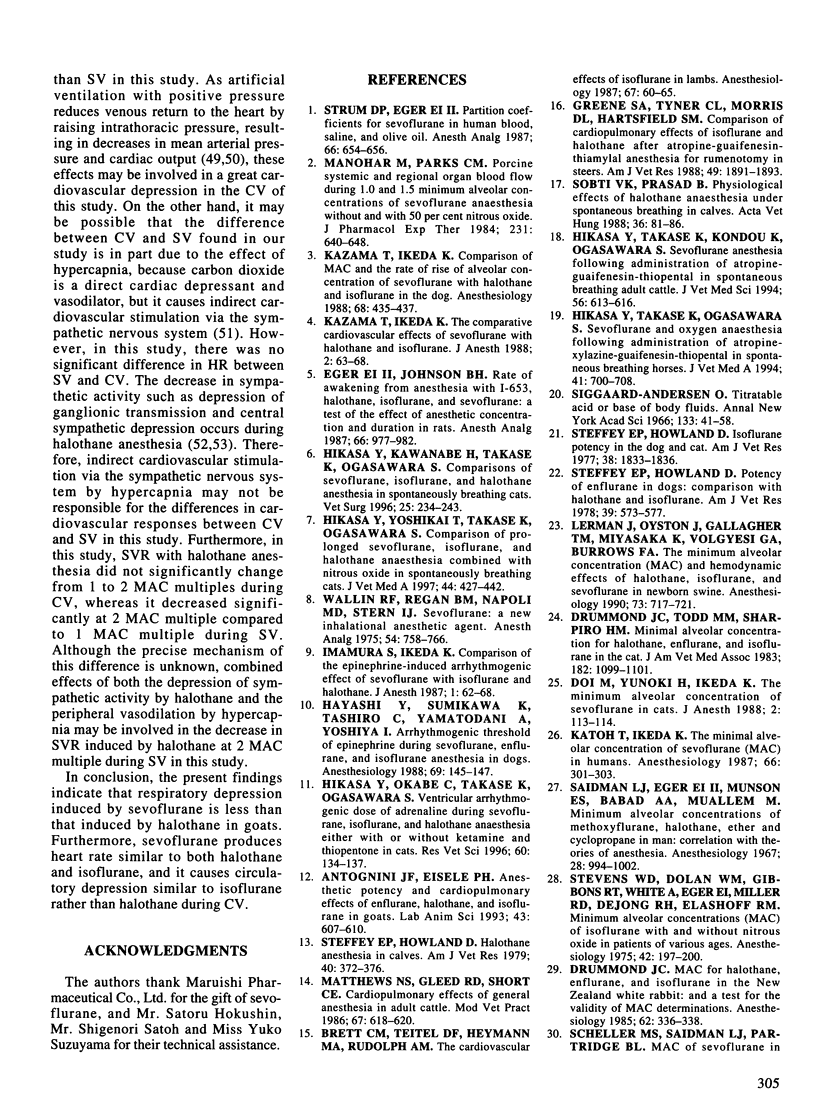
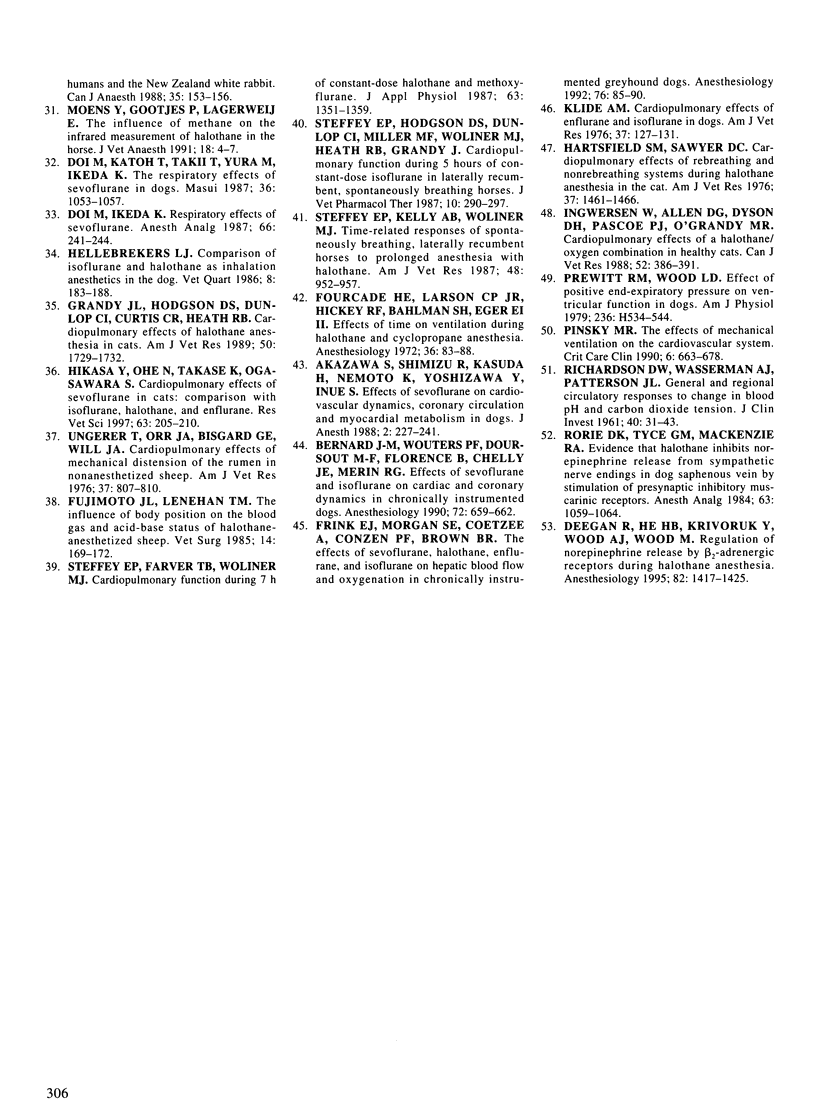
Selected References
These references are in PubMed. This may not be the complete list of references from this article.
- Akazawa S., Shimizu R., Kasuda H., Nemoto K., Yoshizawa Y., Inoue S. Effects of sevoflurane on cardiovascular dynamics, coronary circulation and myocardial metabolism in dogs. J Anesth. 1988 Sep 1;2(2):227–241. doi: 10.1007/s0054080020227. [DOI] [PubMed] [Google Scholar]
- Antognini J. F., Eisele P. H. Anesthetic potency and cardiopulmonary effects of enflurane, halothane, and isoflurane in goats. Lab Anim Sci. 1993 Dec;43(6):607–610. [PubMed] [Google Scholar]
- Bernard J. M., Wouters P. F., Doursout M. F., Florence B., Chelly J. E., Merin R. G. Effects of sevoflurane and isoflurane on cardiac and coronary dynamics in chronically instrumented dogs. Anesthesiology. 1990 Apr;72(4):659–662. doi: 10.1097/00000542-199004000-00014. [DOI] [PubMed] [Google Scholar]
- Brett C. M., Teitel D. F., Heymann M. A., Rudolph A. M. The cardiovascular effects of isoflurane in lambs. Anesthesiology. 1987 Jul;67(1):60–65. doi: 10.1097/00000542-198707000-00011. [DOI] [PubMed] [Google Scholar]
- Deegan R., He H. B., Krivoruk Y., Wood A. J., Wood M. Regulation of norepinephrine release by beta 2-adrenergic receptors during halothane anesthesia. Anesthesiology. 1995 Jun;82(6):1417–1425. doi: 10.1097/00000542-199506000-00013. [DOI] [PubMed] [Google Scholar]
- Doi M., Ikeda K. Respiratory effects of sevoflurane. Anesth Analg. 1987 Mar;66(3):241–244. [PubMed] [Google Scholar]
- Doi M., Katoh T., Takii T., Yura M., Ikeda K. [The respiratory effects of sevoflurane in dogs]. Masui. 1987 Jul;36(7):1053–1057. [PubMed] [Google Scholar]
- Doi M., Yunoki H., Ikeda K. The minimum alveolar concentration of sevoflurane in cats. J Anesth. 1988 Mar 1;2(1):113–114. doi: 10.1007/s0054080020113. [DOI] [PubMed] [Google Scholar]
- Drummond J. C. MAC for halothane, enflurane, and isoflurane in the New Zealand white rabbit: and a test for the validity of MAC determinations. Anesthesiology. 1985 Mar;62(3):336–338. doi: 10.1097/00000542-198503000-00020. [DOI] [PubMed] [Google Scholar]
- Drummond J. C., Todd M. M., Shapiro H. M. Minimal alveolar concentrations for halothane, enflurane, and isoflurane in the cat. J Am Vet Med Assoc. 1983 May 15;182(10):1099–1101. [PubMed] [Google Scholar]
- Eger E. I., 2nd, Johnson B. H. Rates of awakening from anesthesia with I-653, halothane, isoflurane, and sevoflurane: a test of the effect of anesthetic concentration and duration in rats. Anesth Analg. 1987 Oct;66(10):977–982. [PubMed] [Google Scholar]
- Fourcade H. E., Larson C. P., Jr, Hickey R. F., Bahlman S. H., Eger E. I., 2nd Effects of time on ventilation during halothane and cyclopropane anesthesia. Anesthesiology. 1972 Jan;36(1):83–88. doi: 10.1097/00000542-197201000-00017. [DOI] [PubMed] [Google Scholar]
- Frink E. J., Jr, Morgan S. E., Coetzee A., Conzen P. F., Brown B. R., Jr The effects of sevoflurane, halothane, enflurane, and isoflurane on hepatic blood flow and oxygenation in chronically instrumented greyhound dogs. Anesthesiology. 1992 Jan;76(1):85–90. doi: 10.1097/00000542-199201000-00013. [DOI] [PubMed] [Google Scholar]
- Grandy J. L., Hodgson D. S., Dunlop C. I., Curtis C. R., Heath R. B. Cardiopulmonary effects of halothane anesthesia in cats. Am J Vet Res. 1989 Oct;50(10):1729–1732. [PubMed] [Google Scholar]
- Greene S. A., Tyner C. L., Morris D. L., Hartsfield S. M. Comparison of cardiopulmonary effects of isoflurane and halothane after atropine-guaifenesin-thiamylal anesthesia for rumenotomy in steers. Am J Vet Res. 1988 Nov;49(11):1891–1893. [PubMed] [Google Scholar]
- Hartsfield S. M., Sawyer D. C. Cardiopulmonary effects of rebreathing and nonrebreathing systems during halothane anesthesia in the cat. Am J Vet Res. 1976 Dec;37(12):1461–1466. [PubMed] [Google Scholar]
- Hayashi Y., Sumikawa K., Tashiro C., Yamatodani A., Yoshiya I. Arrhythmogenic threshold of epinephrine during sevoflurane, enflurane, and isoflurane anesthesia in dogs. Anesthesiology. 1988 Jul;69(1):145–147. doi: 10.1097/00000542-198807000-00035. [DOI] [PubMed] [Google Scholar]
- Hellebrekers L. J. Comparison of isoflurane and halothane as inhalation anaesthetics in the dog. Vet Q. 1986 Jul;8(3):183–188. doi: 10.1080/01652176.1986.9694041. [DOI] [PubMed] [Google Scholar]
- Hikasa Y., Kawanabe H., Takase K., Ogasawara S. Comparisons of sevoflurane, isoflurane, and halothane anesthesia in spontaneously breathing cats. Vet Surg. 1996 May-Jun;25(3):234–243. doi: 10.1111/j.1532-950x.1996.tb01407.x. [DOI] [PubMed] [Google Scholar]
- Hikasa Y., Ohe N., Takase K., Ogasawara S. Cardiopulmonary effects of sevoflurane in cats: comparison with isoflurane, halothane, and enflurane. Res Vet Sci. 1997 Nov-Dec;63(3):205–210. doi: 10.1016/s0034-5288(97)90021-7. [DOI] [PubMed] [Google Scholar]
- Hikasa Y., Okabe C., Takase K., Ogasawara S. Ventricular arrhythmogenic dose of adrenaline during sevoflurane, isoflurane, and halothane anaesthesia either with or without ketamine or thiopentone in cats. Res Vet Sci. 1996 Mar;60(2):134–137. doi: 10.1016/s0034-5288(96)90007-7. [DOI] [PubMed] [Google Scholar]
- Hikasa Y., Takase K., Kondou K., Ogasawara S. Sevoflurane anesthesia following administration of atropine-guaifenesin-thiopental in spontaneous-breathing adult cattle. J Vet Med Sci. 1994 Jun;56(3):613–616. doi: 10.1292/jvms.56.613. [DOI] [PubMed] [Google Scholar]
- Hikasa Y., Takase K., Ogasawara S. Sevoflurane and oxygen anaesthesia following administration of atropine-xylazine-guaifenesin-thiopental in spontaneously breathing horses. Zentralbl Veterinarmed A. 1994 Nov;41(9):700–708. doi: 10.1111/j.1439-0442.1994.tb00138.x. [DOI] [PubMed] [Google Scholar]
- Hikasa Y., Yoshikai T., Takase K., Ogasawara S. Comparisons of prolonged sevoflurane, isoflurane, and halothane anaesthesia combined with nitrous oxide in spontaneously breathing cats. Zentralbl Veterinarmed A. 1997 Sep;44(7):427–442. doi: 10.1111/j.1439-0442.1997.tb01128.x. [DOI] [PubMed] [Google Scholar]
- Imamura S., Ikeda K. Comparison of the epinephrine-induced arrhythmogenic effect of sevoflurane with isoflurane and halothane. J Anesth. 1987 Mar 1;1(1):62–68. doi: 10.1007/s0054070010062. [DOI] [PubMed] [Google Scholar]
- Ingwersen W., Allen D. G., Dyson D. H., Pascoe P. J., O'Grady M. R. Cardiopulmonary effects of a halothane/oxygen combination in healthy cats. Can J Vet Res. 1988 Jul;52(3):386–391. [PMC free article] [PubMed] [Google Scholar]
- Katoh T., Ikeda K. The minimum alveolar concentration (MAC) of sevoflurane in humans. Anesthesiology. 1987 Mar;66(3):301–303. doi: 10.1097/00000542-198703000-00006. [DOI] [PubMed] [Google Scholar]
- Kazama T., Ikeda K. Comparison of MAC and the rate of rise of alveolar concentration of sevoflurane with halothane and isoflurane in the dog. Anesthesiology. 1988 Mar;68(3):435–437. doi: 10.1097/00000542-198803000-00020. [DOI] [PubMed] [Google Scholar]
- Kazama T., Ikeda K. The comparative cardiovascular effects of sevoflurane with halothane and isoflurane. J Anesth. 1988 Mar 1;2(1):63–68. doi: 10.1007/s0054080020063. [DOI] [PubMed] [Google Scholar]
- Klide A. M. Cardiopulmonary effects of enflurane and isoflurane in the dog. Am J Vet Res. 1976 Feb;37(2):127–131. [PubMed] [Google Scholar]
- Lerman J., Oyston J. P., Gallagher T. M., Miyasaka K., Volgyesi G. A., Burrows F. A. The minimum alveolar concentration (MAC) and hemodynamic effects of halothane, isoflurane, and sevoflurane in newborn swine. Anesthesiology. 1990 Oct;73(4):717–721. doi: 10.1097/00000542-199010000-00018. [DOI] [PubMed] [Google Scholar]
- Manohar M., Parks C. M. Porcine systemic and regional organ blood flow during 1.0 and 1.5 minimum alveolar concentrations of sevoflurane anesthesia without and with 50% nitrous oxide. J Pharmacol Exp Ther. 1984 Dec;231(3):640–648. [PubMed] [Google Scholar]
- Pinsky M. R. The effects of mechanical ventilation on the cardiovascular system. Crit Care Clin. 1990 Jul;6(3):663–678. [PubMed] [Google Scholar]
- Prewitt R. M., Wood L. D. Effect of positive end-expiratory pressure on ventricular function in dogs. Am J Physiol. 1979 Apr;236(4):H534–H544. doi: 10.1152/ajpheart.1979.236.4.H534. [DOI] [PubMed] [Google Scholar]
- RICHARDSON D. W., WASSERMAN A. J., PATTERSON J. L., Jr General and regional circulatory responses to change in blood pH and carbon dioxide tension. J Clin Invest. 1961 Jan;40:31–43. doi: 10.1172/JCI104234. [DOI] [PMC free article] [PubMed] [Google Scholar]
- Rorie D. K., Tyce G. M., Mackenzie R. A. Evidence that halothane inhibits norepinephrine release from sympathetic nerve endings in dog saphenous vein by stimulation of presynaptic inhibitory muscarinic receptors. Anesth Analg. 1984 Dec;63(12):1059–1064. [PubMed] [Google Scholar]
- Saidman L. J., Eger E. I., 2nd, Munson E. S., Babad A. A., Muallem M. Minimum alveolar concentrations of methoxyflurane, halothane, ether and cyclopropane in man: correlation with theories of anesthesia. Anesthesiology. 1967 Nov-Dec;28(6):994–1002. doi: 10.1097/00000542-196711000-00009. [DOI] [PubMed] [Google Scholar]
- Scheller M. S., Saidman L. J., Partridge B. L. MAC of sevoflurane in humans and the New Zealand white rabbit. Can J Anaesth. 1988 Mar;35(2):153–156. doi: 10.1007/BF03010656. [DOI] [PubMed] [Google Scholar]
- Siggaard-Andersen O. Titratable acid or base of body fluids. Ann N Y Acad Sci. 1966 Apr 1;133(1):41–58. doi: 10.1111/j.1749-6632.1966.tb50707.x. [DOI] [PubMed] [Google Scholar]
- Sobti V. K., Prasad B. Physiological effects of halothane anaesthesia under spontaneous breathing in calves. Acta Vet Hung. 1988;36(1-2):81–86. [PubMed] [Google Scholar]
- Steffey E. P., Farver T. B., Woliner M. J. Cardiopulmonary function during 7 h of constant-dose halothane and methoxyflurane. J Appl Physiol (1985) 1987 Oct;63(4):1351–1359. doi: 10.1152/jappl.1987.63.4.1351. [DOI] [PubMed] [Google Scholar]
- Steffey E. P., Hodgson D. S., Dunlop C. I., Miller M. F., Woliner M. J., Heath R. B., Grandy J. Cardiopulmonary function during 5 hours of constant-dose isoflurane in laterally recumbent, spontaneously breathing horses. J Vet Pharmacol Ther. 1987 Dec;10(4):290–297. doi: 10.1111/j.1365-2885.1987.tb00104.x. [DOI] [PubMed] [Google Scholar]
- Steffey E. P., Howland D., Jr Halothane anesthesia in calves. Am J Vet Res. 1979 Mar;40(3):372–376. [PubMed] [Google Scholar]
- Steffey E. P., Howland D., Jr Isoflurane potency in the dog and cat. Am J Vet Res. 1977 Nov;38(11):1833–1836. [PubMed] [Google Scholar]
- Steffey E. P., Howland D., Jr Potency of enflurane in dogs: comparison with halothane and isoflurane. Am J Vet Res. 1978 Apr;39(4):573–577. [PubMed] [Google Scholar]
- Steffey E. P., Kelly A. B., Woliner M. J. Time-related responses of spontaneously breathing, laterally recumbent horses to prolonged anesthesia with halothane. Am J Vet Res. 1987 Jun;48(6):952–957. [PubMed] [Google Scholar]
- Stevens W. C., Dolan W. M., Gibbons R. T., White A., Eger E. I., Miller R. D., DeJong R. H., Elashoff R. M. Minimum alveolar concentrations (MAC) of isoflurande with and without nitrous oxide in patients of various ages. Anesthesiology. 1975 Feb;42(2):197–200. doi: 10.1097/00000542-197502000-00014. [DOI] [PubMed] [Google Scholar]
- Strum D. P., Eger E. I., 2nd Partition coefficients for sevoflurane in human blood, saline, and olive oil. Anesth Analg. 1987 Jul;66(7):654–656. [PubMed] [Google Scholar]
- Ungerer T., Orr J. A., Bisgard G. E., Will J. A. Cardiopulmonary effects of mechanical distension of the rumen in nonanesthetized sheep. Am J Vet Res. 1976 Jul;37(7):807–810. [PubMed] [Google Scholar]
- Wallin R. F., Regan B. M., Napoli M. D., Stern I. J. Sevoflurane: a new inhalational anesthetic agent. Anesth Analg. 1975 Nov-Dec;54(6):758–766. doi: 10.1213/00000539-197511000-00021. [DOI] [PubMed] [Google Scholar]


